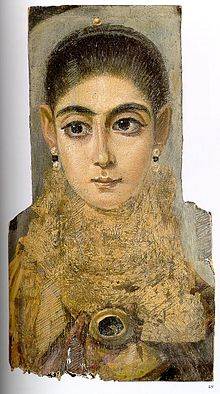
Back لوحات مومياوات الفيوم Arabic بورتريهات الفيوم ARZ Fəyyum portretləri Azerbaijani Фаюмски портрети Bulgarian Retrats del Faium Catalan Fajjúmské mumiové portréty Czech Ægyptiske mumieportrætter Danish Mumienporträt German Πορτραίτα Φαγιούμ Greek Retratos de El Fayum Spanish


Mummy portraits or Fayum mummy portraits are a type of naturalistic painted portrait on wooden boards attached to upper class mummies from Roman Egypt. They belong to the tradition of panel painting, one of the most highly regarded forms of art in the Classical world. The Fayum portraits are the only large body of art from that tradition to have survived. They were formerly, and incorrectly, called Coptic portraits.
Mummy portraits have been found across Egypt, but are most common in the Faiyum Basin, particularly from Hawara and the Hadrianic Roman city Antinoopolis. "Faiyum portraits" is generally used as a stylistic, rather than a geographic, description. While painted cartonnage mummy cases date back to pharaonic times, the Faiyum mummy portraits were an innovation dating to the time of Roman rule in Egypt.[1] The portraits date to the Imperial Roman era, from the late 1st century BC or the early 1st century AD onwards. It is not clear when their production ended, but some research suggests the middle of the 3rd century. They are among the largest groups among the very few survivors of the panel painting tradition of the classical world, which continued into Byzantine, Eastern Mediterranean, and Western traditions in the post-classical world, including the local tradition of Coptic Christian iconography in Egypt.
The portraits covered the faces of bodies that were mummified for burial. Extant examples indicate that they were mounted into the bands of cloth that were used to wrap the bodies. Almost all have now been detached from the mummies.[2] They usually depict a single person, showing the head, or head and upper chest, viewed frontally. In terms of artistic tradition, the images clearly derive more from Greco-Roman artistic traditions than Egyptian ones.[3] Two groups of portraits can be distinguished by technique: one of encaustic (wax) paintings, the other in tempera. The former are usually of higher quality.
About 900 mummy portraits are known at present.[4] The majority were found in the necropolis of Faiyum. Due to the hot dry Egyptian climate, the paintings are frequently very well preserved, often retaining their brilliant colours seemingly unfaded by time.
- ^ Berman, Lawrence; Freed, Rita E.; and Doxey, Denise. Arts of Ancient Egypt. p. 193. Museum of Fine Arts Boston. 2003. ISBN 0-87846-661-4
- ^ Examples still attached are in the Egyptian Museum, Cairo and the British Museum
- ^ Oakes, Lorna; Gahlin, Lucia. Ancient Egypt: An Illustrated Reference to the Myths, Religions, Pyramids and Temples of the Land of the Pharaohs. p. 236 Hermes House. 2002. ISBN 1-84477-008-7
- ^ Corpus of all known specimens: Klaus Parlasca (1969–2003). Ritratti di mummie. Repertorio d'arte dell'Egitto greco-romano Serie B, v. 1-4. Rome.
{{cite book}}: CS1 maint: location missing publisher (link)A further specimen discovered since: B. T. Trope; S. Quirke; P. Lacovara (2005). Excavating Egypt: great discoveries from the Petrie Museum of Egyptian Archaeology, University College, London. Atlanta, Georgia: Michael C. Carlos Museum. p. 101. ISBN 1-928917-06-2.